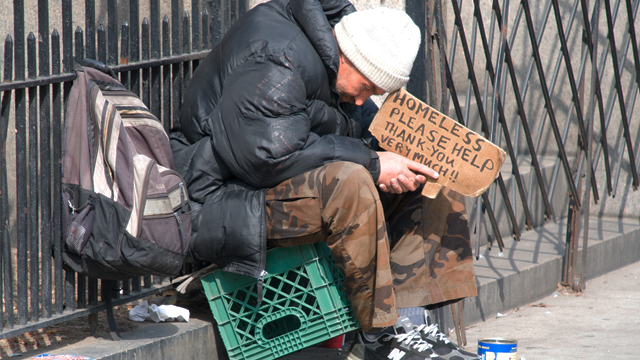This post first appeared at The American Prospect.

(Photo:Ed Yourdon/flickr CC 2.0)
In an era of shrinking financial resources, policymakers, providers and activists who work on homelessness prevention and care in the United States have been forced to develop new strategies. There was a time when officials at the Department of Housing and Urban Development (HUD) saw it as their responsibility to provide both housing and supportive services for homeless individuals, but now HUD is refocusing its budget predominately on rent and housing — with the hope that other local, state, and federal agencies will play a greater role in providing supportive care. However, whether other organizations will actually be able to pick up those costs and responsibilities remains unclear.
The first major federal legislative response to homelessness was the McKinney-Vento Act of 1987, which passed both the House and Senate with large bipartisan majorities. The McKinney Act — which Bill Clinton later renamed the McKinney-Vento Homeless Assistance Act — provided funds not only for emergency shelter, transitional housing, and permanent housing, but also for job training, primary health care, mental health care, drug and alcohol treatment, education programs, and other supportive services. The consensus was that homelessness is a complex problem whose solution requires more than simply a roof and a bed.
The statutory goal of the McKinney Act was to gradually move homeless people toward stable housing and independence — a model that came to be known as “Housing Readiness.” Though this sprung from well-meaning intentions, it eventually became clear that this “gradual” approach frequently led to unwise and unfair ways of distributing welfare.
“We had this system that said homeless people essentially have to earn their way to permanent housing,” explained Ed Stellon, the senior director of the Midwest Harm Reduction Institute, and someone who has worked within the substance use and mental health treatment systems for more than 20 years. “Homeless people had to earn their way into transitional housing, make progress on certain goals, and finally when they were deemed well enough, they would earn their spot in permanent housing.”
A different model, known as “Housing First”, has been gaining steam over the past decade. What at first sounded revolutionary now feels fairly obvious: The Housing First approach posits that the only requirement for housing should be homelessness — that shelter is a right, not a privilege. “Plus, if you have conditions like out-of-control diabetes, congestive heart failure, or schizophrenia, housing is actually part of the solution,” adds Stellon. “It’s hard to make any meaningful progress on these chronic conditions without stable housing.”
Though exact estimates are hard to come by, HUD recently reported that as of January 2014, the chronically homeless numbered some 84,291, with 63 percent of those individuals living on the streets. HUD says this number has declined by 21 percent, or 22,937 persons, since 2010 — in large part because of the embrace of Housing First. (Some, however, have accused the federal government of using data gimmicks to paint a more cheery picture of progress than has actually been made.)
Nevertheless, the reality is that at the same time policymakers are embracing the idea of Housing First, fewer affordable housing units exist than ever before. According to the National Low Income Housing Coalition, federal support for low-income housing has fallen 49 percent between 1980 and 2003, and the Joint Center for Housing Studies found about 200,000 rental units are destroyed annually. Research also suggests that a supply of 8.2 million more units would be needed to house extremely low-income households, up from a gap of 5.2 million a decade earlier. Though Congress recently authorized funding for the National Housing Trust Fund — an entity that was created in 2008 to fund affordable housing projects — its budget is nowhere near large enough to meet the demand.
“We’re not doing enough to expand housing availability, and HUD can’t expand its services unless Congress allocates it more funding,” says Barbara DiPietro, the director of policy for the National Health Care for the Homeless Council.
Given the fiscal climate, HUD is looking for new ways to spend its increasingly limited budget. Consequently, the agency is moving away from the supportive services that, through the McKinney-Vento Act, once accounted for most of its spending. In 1998, for instance, 55 percent of HUD’s budget was spent on supportive services, and 45 percent was awarded for housing. By 2013, just 26 percent of HUD’s competitive homeless assistance funds went to supportive services, and 66 percent was spent on housing. According to Ann Oliva, director of HUD’s Office of Special Needs Assistance Programs, the department’s goal now is to help local communities become more strategic with existing resources and available opportunities.
To do this, HUD has been working closely with other federal agencies, especially the Department of Health and Human Services (HHS), the Department of Veterans Affairs (VA), and the US Interagency Council on Homelessness. In 2008, a joint program known as HUD-Veterans Affairs Supportive Housing (HUD-VASH) launched, combining housing vouchers for homeless veterans provided by HUD, with case management and clinical services provided by the VA Experts agree that HUD-VASH has been quite successful in helping both vets and their families, and it’s typically held up as the poster child for future interagency collaborative efforts. However, the program came with additional appropriated dollars, and it is typically easier to convince Congress to fund programs for impoverished military veterans compared to other downtrodden groups.
One of the most significant recent changes to homelessness policy has come through the expansion of Medicaid — a key feature of the Affordable Care Act. Now that nearly all individuals with incomes up to 138 percent of the federal poverty level are eligible for health insurance in states that opt for the expansion, agencies are scrambling to enroll thousands of homeless people so that they may benefit from new streams of mandatory government spending.
But Medicaid is, at its heart, a program controlled by the states. And with some states still vigorously opposed to expanding Medicaid — despite the ACA’s mandate for the federal government to pick up nearly all of the tab for the expansion — let alone some of the flexible legislative adaptations that HHS is encouraging, consistent and widespread changes to supportive services seem unlikely in the near future.
Though Medicaid expansion presents great opportunities for providing services to the homeless, some are concerned that the more flexible federal dollars currently set aside to work with homeless people will eventually just be funneled into the larger health insurance pool, with little, if any, allocated to doing what it takes to bring those with no homes into the government support system, which is needed in order to provide preventive care.
“Going out four or five times to visit with a woman living alone under a bridge, just trying to form a relationship and build trust with her so she will feel comfortable coming in to get more help — those types of health encounters are not typically billable through health insurance,” adds Stellon, who says outreach can be one of the hardest things for him to fund. “In our current system, it’s easier to pay for someone’s amputated fingers than to build a human relationship.”
Ultimately, there is only so much the government can do to advance the goal of Housing First with a depleting stock of housing units and a shrinking budget for supportive services.
“It’s a big mistake to come up with a good solution like Housing First and then to hamstring it because we don’t actually have the money for it,” says Todd Stull, the clinical director at JOURNEYS | The Road Home, an organization that provides services and shelter to families and individuals in Illinois’s North and Northwest suburban Cook County. “One of the worst things you can do is get someone into housing for a short period of time and then they lose it. Then they lose trust in the providers.”
“We have not done well as a nation taking on poverty and implementing policies needed to address homelessness,” says Dr. Sam Tsemberis, the founder and CEO of Pathways to Housing, a national organization that first pioneered the Housing First model in 1992. “So we end up taking care of homelessness out of desperation, but we’ll be taking care of homelessness forever if we don’t take care of poverty.”
“We need more money,” adds DiPietro. “Until then, we’re just rearranging the priority list.”


